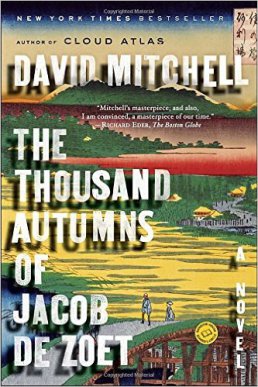 A devout young clerk entering Dejima in Nagasaki Harbor with a Dutch trade ship, Jacob De Zoet has five years to earn enough money to be able to marry his fiancee, Anna. However, Jacob quickly finds himself falling for a midwife named Orito Aibagawa, who is distinguished by a burn covering the left side of her face. When she is removed from the city and placed in a shrine run by Lord Abbot Enomoto, Jacob can’t help but worry for her safety when he learns the truth behind the goings on in the shrine.
A devout young clerk entering Dejima in Nagasaki Harbor with a Dutch trade ship, Jacob De Zoet has five years to earn enough money to be able to marry his fiancee, Anna. However, Jacob quickly finds himself falling for a midwife named Orito Aibagawa, who is distinguished by a burn covering the left side of her face. When she is removed from the city and placed in a shrine run by Lord Abbot Enomoto, Jacob can’t help but worry for her safety when he learns the truth behind the goings on in the shrine.
With this being the sixth book I have read written by David Mitchell, I would have to say that The Thousand Autumns of Jacob De Zoet lands somewhere in the middle for me. Honestly, I find it extremely difficult to place Mitchell’s books in any kind of ranking order because there are aspects about each of his works that I really enjoy. I place The Thousand Autumns somewhere in the middle, though, because it took me a while to get into the story. I was hooked right away with the first chapter, which gave the reader the first glimpse of Orito Aibagawa, but after the point of view switched to Jacob De Zoet it took me about 50 pages or so to understand what was going on. Maybe I was tired on the night I started to read it, or maybe Mitchell’s writing wasn’t too clear, but once I finally understood that they were merchants coming into Nagasaki Harbor to set up trade I was able to fully immerse myself. I did also find Mitchell’s narrative to be similar to his narrative in Cloud Atlas which took me a long time to get into compared with The Bone Clocks or Slade House.
My favorite part of the book was the second section, which followed Orito Aibagawa. Compared with the sections that focused mainly on Jacob, I found the parts about Orito to be more engaging and interesting. The second section also helped set up the premise of The Bone Clocks, which would probably be my favorite book by Mitchell. As a writer, the fact that Mitchell can seamlessly work characters and plots into several of his novels always impresses me. This is just one of the reasons I tend to recommend Mitchell’s works to anyone and everyone. The second is that I find Mitchell’s writing style to be captivating with a sense of realism that helps bring the story to life.
Advertisements Sharing is caring:




